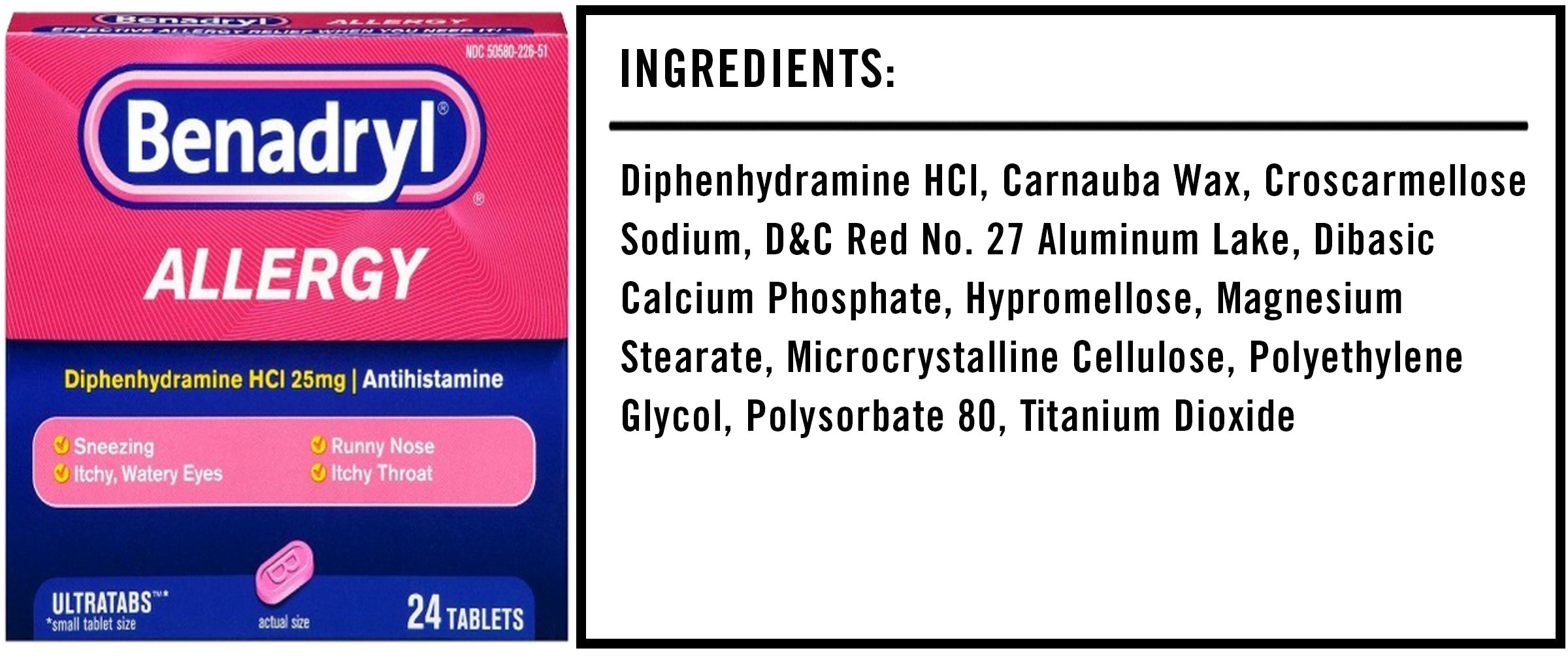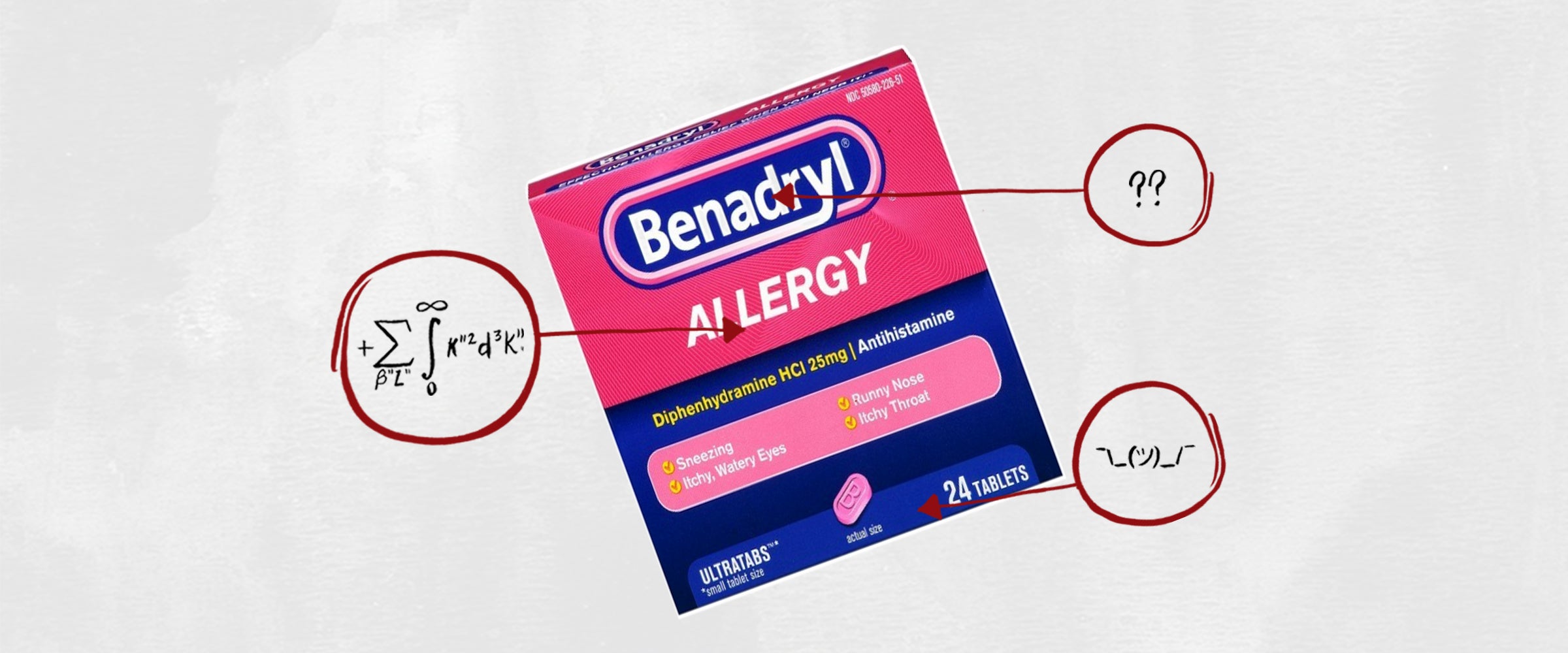We’re often told that you should never eat anything (or put anything on your body) if you don’t recognize everything on the ingredients list. But since most of us have no idea what xanthan gum or potassium benzoate are — or more importantly, what they’re doing to our bodies — we’re decoding the ingredients in the many things Americans put in (and on) themselves with the help of an expert.
This edition: Benadryl, which is made from 11 separate ingredients that we’ve broken down in the exact order they appear on their website.
The Ingredients

1) Diphenhydramine HCl: Diphenhydramine is the one and only active ingredient in Benadryl, and it works by blocking the action of histamine, a substance in the body that causes allergy symptoms, like redness, irritation, itchiness and sneezing, among other things.
One pervasive side effect that comes with diphenhydramine, though, is that it can make you sleepy. This happens because histamines also play a pivotal role in regulating sleep and wakefulness, so when this drug blocks that process, you often end up feeling drowsy.
2) Carnauba Wax: “Carnauba wax is a water insoluble substance used as a glazing, bulking and anticaking agent,” Dagan Xavier, ingredient expert and co-founder of Label Insight, told me during my analysis of the ingredients in Orbit White Spearmint Gum. This particular wax is sourced from the copernicia prunifera, a plant grown only in northeastern Brazil.
3) Croscarmellose Sodium: Derived from plant fibers, croscarmellose sodium is frequently added to pharmaceutical tablets to ensure that the drug is dissolved and absorbed in the intestines.
4) D&C Red No. 27 Aluminum Lake: This is what gives Benadryl tablets their pink color. Despite artificial colors having a bad reputation, physician and biochemist Cate Shanahan, author of Deep Nutrition: Why Your Genes Need Traditional Food, previously told me that studies arguing this are a bit flawed: “I’ve always been of the opinion that studies claiming artificial colors can cause cancer are irrelevant because [in the studies] they use really high amounts of the artificial colors — like, a million times more than you’d ever get [in your] food [throughout your lifetime].”
5) Dibasic Calcium Phosphate: Dibasic calcium phosphate is often used in pharmaceutical tablets as an excipient, meaning it essentially acts as a vehicle for the other active ingredients.
6) Hypromellose: This is often used as a coating agent to control how quickly drugs in tablet form are released within the body.
7) Magnesium Stearate: Magnesium stearate is a fine white powder frequently used as a release agent, meaning it prevents the various individual ingredients in these tablets from sticking to each other (and the machines) during production.
8) Microcrystalline Cellulose: This is refined wood pulp, which makes up the casing for these tablets.
9) Polyethylene Glycol: This is often used to treat constipation and can be found in popular laxatives, like Miralax. It works by increasing the flow of water into the intestines, which produces easier-to-pass stools.
It’s here because the diphenhydramine in Benadryl can prevent acetylcholine, a chemical that helps the bowel muscles move, from working properly, which can lead to constipation. The poop-inducing properties of polyethylene glycol are meant to help combat this.
10) Polysorbate 80: This is primarily used as an emulsifier, meaning it helps the various ingredients in these tablets blend together. Eating large amounts of polysorbate 80 is a bad idea, though: It promotes inflammatory bowel disease and a cluster of obesity-related diseases known as metabolic syndrome, according to a 2015 animal study. So go easy on the Benadryl, buddy.
11) Titanium Dioxide: This basically prevents discoloration. Unfortunately, the European Chemical Agency has concluded that titanium dioxide may cause cancer when inhaled, although the minuscule amounts in Benadryl are most likely harmless.
The Takeaway
Benadryl does what it promises, and I can appreciate that they added polyethylene glycol to help with the constipation that might otherwise come along with this medication. There are, however, some studies that suggest taking Benadryl or other sleep aids that contain diphenhydramine regularly can contribute to cancer and the development of dementia. Realistically, though, taking Benadryl whenever you have an allergic reaction is probably fine, but understand that you might be stepping into dangerous territory by taking it every night before bed.

